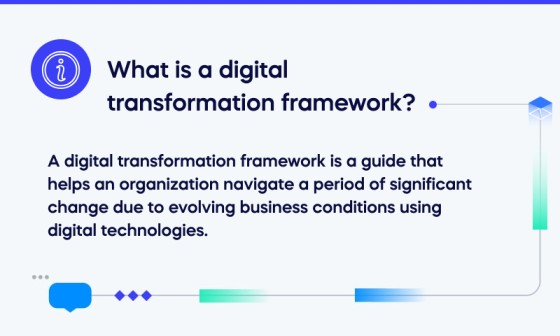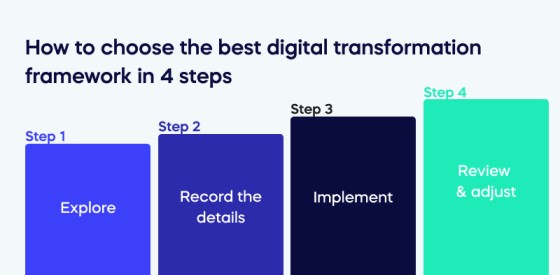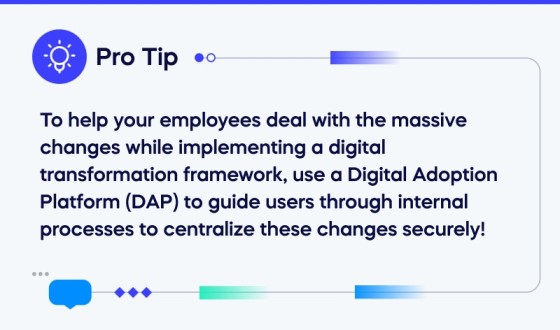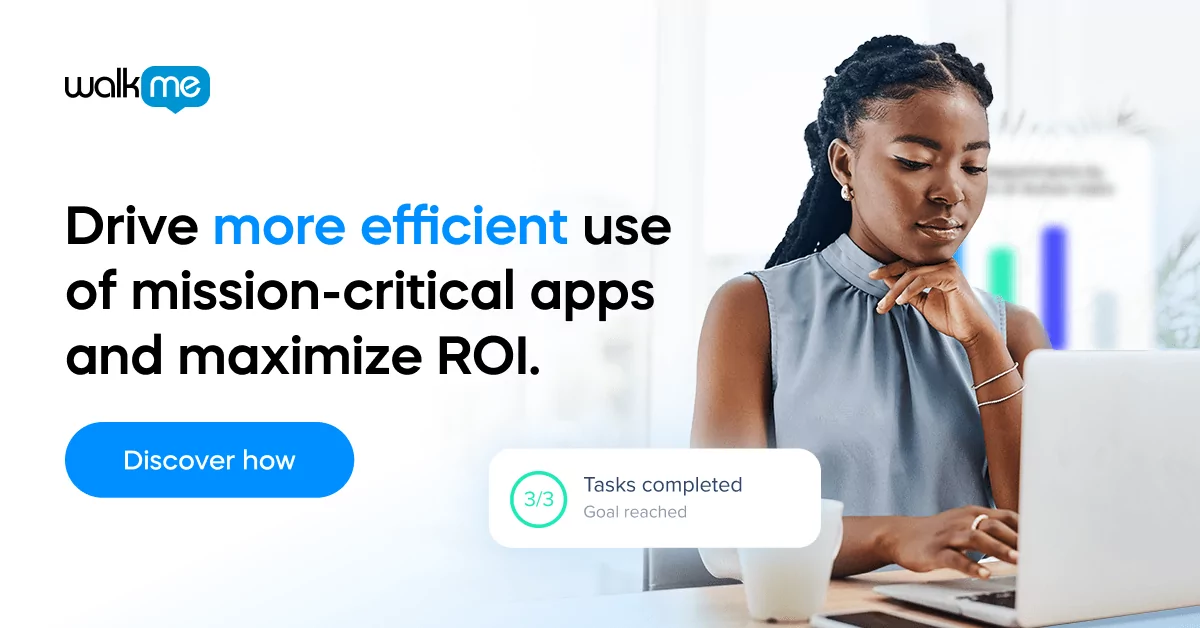How do you deploy a structured response to the ever-changing business world in the digital age?
Trying to do so is undoubtedly a huge challenge, as being flexible and structured simultaneously is impossible, right?
Not if you use a digital transformation framework that guides your digital transformation systematically and structurally to ensure success.
What is a digital transformation framework?

A digital transformation framework is a guide that helps an organization navigate a period of significant change due to evolving business conditions using digital technologies. All levels of the organization use it as a blueprint for the transformation journey.
Why is a digital transformation framework important?
A good digital transformation framework is important in helping organizations establish a consistent way of identifying issues, developing strategies, and implementing changes for businesses seeking to reposition themselves in the digital economy.
Another function is that the framework empowers digital transformation professionals to have control over the aspects that enable the business to be transformed, with a focus beyond technology to streamline the digital transformation process.
Above all, a digital transformation framework prioritizes customer value, market position, and competitors over technology, avoiding distractions from shiny new technologies.
Can you explain what your business is transforming into more clearly? If you struggle articulating it, you may benefit from using frameworks to help with planning, communication, innovation, and technology decisions.
What are the organizational benefits of a digital transformation framework?
Consider the benefits of the digital transformation framework to understand the reasons to invest in different models.
A digital transformation framework is an essential tool that unifies different parts of an organization and provides a shared starting point for all teams. It will bring both general and specific benefits to various departments.
Leaders
Benefits to leaders include:
- A structured approach to guide through a change period.
- An accessible, organization-wide program for reference.
- The capability to reevaluate a vision of success for the company and define digital transformation strategies.
The board of directors
Benefits to the board of directors include:
- A framework providing governance insights.
- A working straw-man to measure progress towards goals.
Your employees
Benefits to your employees include:
- A framework providing all employees with a view of what’s ahead.
- A view of the change and their involvement.
- The chance to work in a cross-functional team to achieve all goals.
Operations
Benefits to your operations include:
- A framework to see the actions and tools needed during the transformation.
- Guidelines that map the existing and end goal state.
- A view of the cross-organizational effects of the planned changes.
Finances
Benefits to the finances department include:
- Guidelines for understanding the tools and actions needed during the period of change.
- The deadline to map the existing and future state.
- The opportunity to develop a new, incremental way of working and solving problems.
Technologies
Benefits of the technologies you use include:
- A deadline to assess current skills and systems versus the required future state strategies to digitally transform systems using digital tools like the Internet of Things (IoT), social media, digital marketing, Cloud, and Big Data.
- The opportunity to develop a new, incremental way of working and solving problems using digital technology to promote digital resilience.
Internal Comms
Benefits to the internal comms include:
- Guidelines to understand tools and actions needed during the period of change.
- A deadline to engage with employees, hear their concerns and celebrate any successes.
- The chance to review all communication with employees leveraging any new technologies.
Shareholder relationships
Benefits to shareholder relationships include:
- Guidelines to understand tools and actions required during the period while ensuring robust client relationship management.
- The chance to review all communication with shareholders leveraging new technologies.
- The chance to pass on the ongoing story of the organization’s transformation from the former state to the transformed organization.
Legal division
Benefits to your legal division will include the following:
- A guideline to understand legal actions and tools required during the period of change.
- The opportunity to develop a new, iterative way of working and solving problems.
- The mandate is to assess current systems and skills versus the required future state systems and skills – Cloud, social media, Internet of Things (IoT), Big Data, and Mobile.
- The opportunity to develop a new, incremental way of working and solving problems.
Human Resources (HR)
Benefits to your HR team will include:
- Guidelines to see what actions and tools you will need during the period of change.
- A deadline to engage with employees, hear their concerns and celebrate any successes.
- A deadline to review the current organizational culture and design a pathway to improving it.
Consider these benefits to optimize your use of a digital transformation framework.
How to choose the best digital transformation framework in 4 steps

Suitable digital frameworks should be flexible enough to suit an organization’s needs and practical to implement in logical steps that demonstrate tangible progress.
The first phases (exploration and specific details) focus on ensuring the organization understands what it is doing and why it is necessary.
The subsequent phases (implementation, review & adjustment) concentrate on execution and the ongoing operational environment.
1. Explore
First, you must explore your vision of why you need a digital transformation framework using insights to drive your exploration.
Build a vision
The organization needs to have a clear idea of what it wants to achieve in the future for the company, its employees, its customers, and the marketplace it serves.
Consider enlisting the support of digital transformation consulting companies if you have limited experience with digital transformations.
Rationale
Your organization should not only change in response to commercial pressures. The organization needs to establish a purpose for change that all employees can understand and support, which also holds meaning for its customers.
You may want to try new business models, for example, to break into a new market, requiring a new digital transformation project and a framework to guide success.
Data insights
Every organization should use its internal insights and knowledge to decide its future state.
2. Record the details
Next, record the details to ensure you have a robust guide for the future of your digital transformation framework.
Strong leadership
A digital transformation is a significant undertaking that requires a dedicated executive to lead it. This executive should have the backing of the Board, CEO, and other leaders in the organization.
A robust, tailored strategy
Your digital transformation strategy needs to cover a thorough review of the market, laws, regulations, and competitors.
It should analyze the organization’s current situation, define the desired goals, set clear metrics for measuring success at every step, specify changes you must make, and explain how to implement them.
It is crucial to focus on changing the mindset of doing things differently and understanding the process to achieve success in digital transformation.
Additionally, metrics are essential for tracking progress. These two factors are crucial elements of a digital transformation strategy.
Map for the future
Develop a roadmap to outline the stages of the transformation process. Adjust and modify as needed.
3. Implement
The next stage is to implement the framework you have chosen.
The right language
The digital transformation framework’s most significant advantage is creating a vocabulary for the organization.
User streams
Separate streams for each core area of the organization: people, customers, process, product, and technology.
Driving a new culture
A digital transformation framework program oversees the development and adjustment of the organizational culture according to changes.
It involves regular communication, workshops, and other activities to provide a comprehensive view of the change process, its results, and advancement to all levels of the organization.
4. Review & adjust
The step often missed due to time constraints but is essential to long-term success is reviewing and adjusting the framework according to unexpected changes.
Review
Regularly assess metrics to track our progress toward the final goal. This information is shared with the Board and Leadership and guides the culture and communications plan.
Use benchmarks for comparison
Correctly measure new methods against old ones; it’s essential to create new benchmarks from the beginning of the transformation.
Use a DAP to implement your digital transformation framework
The digital transformation framework is imperative for all businesses in this modern, tech-driven world.
It provides a comprehensive overview of what a successful digital transformation looks like and helps business leaders see the bigger picture with concrete steps to structure their journey.

To help your employees deal with the massive changes while implementing a digital transformation framework, use a Digital Adoption Platform (DAP) to guide users through internal processes to centralize these changes securely!
With in-app guidance and personalized learning, a DAP will guide you on the path to success along your digital transformation journey as you digitally transform to embrace the future.


